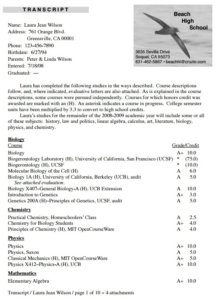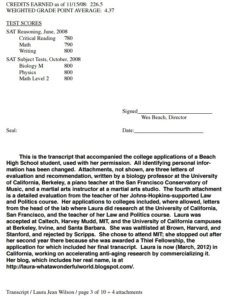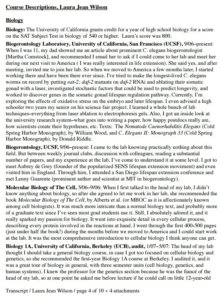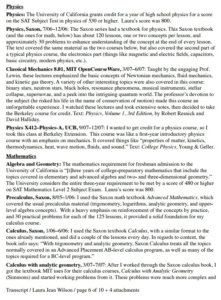This excerpt from “Forging Paths: Beyond Traditional Schooling”, by Wes Beach, takes a look at a number of examples of high school transcripts.
Author: Beach, W.
Year: 2012
Writing Transcripts
In California and more than a dozen other states, state laws allow homeschooling families to set up their own private schools. Beach High School was established and is maintained under these same laws. I can do everything that any other school can do in spite of the fact that I have no classrooms, athletic fields, or teachers. Your state’s laws may similarly allow you to direct your own school. (Please check with your local homeschool association or network for more information.)
If you are in a state where you cannot set up a school, you can nevertheless write a transcript to supplement or use in place of a traditional school transcript. On a transcript, you can document all learning regardless of how it was acquired or where it took place. . . .
Here are some guidelines to follow if you write a transcript for your daughter or son.
There is no universally-expected format for a high school transcript.
Design a format that best presents, in an easy-to-understand way, the abilities and accomplishments of the person it represents. Do not use a template unless you cannot think of a better way to show the information that needs to be shown. If a transcript is very long, show a summary up front and follow with details, like course descriptions, evaluative letters, etc.
The amount of detail included on a transcript depends on how much outside evaluation can be provided.
If most academic work has been done officially at recognized institutions, little detail is required. If most work has been done independently without institutional credit having been given, a great deal of detail should be included; a simple list of courses, grades, and credits will not do the job. Any or all of the following elements can be included when a detailed transcript is needed.
Heading
This can include the name and location of your school and the student’s name, address, phone number, date of birth, parent(s)’s name(s), date of enrollment, and graduation date.
Course List
This list can include course titles, grades, credits, and possibly brief pieces of narrative. Course titles should be as descriptive as possible, while also being brief; for example, “U.S. History–WWII to the Present” rather than simply “History.” If courses have been taken at various places, include a key explaining indicative symbols included with course titles. Courses can be listed chronologically or by subject, and as year, semester, or quarter courses. I don’t think it’s possible to accurately describe and measure anyone’s learning or achievement with numbers and letters of the alphabet, so don’t worry about being exact or comparing what your son or daughter has done with what others do in high school. Just assign grades and credits that make sense to you. In California, most high schools award 10 credits for a typical year’s work; in many other states, it’s 1 credit for a year course. If something has been of greater value than usual, you can assign more credits, fractional if necessary. You can also assign fewer. Courses can be designated as honors courses when levels of achievement warrant it.
Here’s a short section of a course list.

This list was preceded by a key, showing, for example, that SD stands for “self-designed coursework.”
Credits and GPA
Provide a total number of credits and a grade point average (GPA). An A is worth 4 grade points, a B 3, and so on. Honors courses get an extra grade point. Here’s a simple example of a GPA computation.
1 A in an honors course: 1 grade x 5 grade points = 5 grade points
3 Aʼs: 3 x 4 = 12
1 A-: 1 x 3.7 = 3.7
2 Bʼs: 2 x 3 = 6
Grade point total: 26.7
Grade points divided by number of grades = 26.7 / 7 = 3.81 = GPA
Narratives
Use narratives of any length wherever necessary to provide clear explanations of your kid’s home education. Explanations can be a description of your homeschooling philosophy and methods, a piece written by your son or daughter, course descriptions, etc. For example:
The Pelican County Co-op is a support network of homeschooling parents. We are from Brownville, Greenburg, Red Hill, Black City, and surrounding areas. We share our talents and energies in a co-operative environment. PCC meets regularly for the purpose of providing enjoyable, creative, and educational activities so our children can celebrate the adventures of learning and explore their world together. . . . A wide variety of co-op groups—book discussion clubs, for example—are organized for children of all ages to share and explore in such subjects as literature, history, math, and science.
Course Descriptions
Course descriptions should include content, methods, and materials used. Laura [Wilson] wrote all her course descriptions; [see the examples on pages 7-9].
Reading Lists You can include a comprehensive list or separate lists for different subject areas.
Letters of Evaluation/Recommendation
Entire letters and/or excerpts can be used. A short excerpt might be included as part of a course description, a course listing might include a note that says “See attached evaluation,” or a more general letter can simply be added to a transcript.
Other Documentation
Include anything that adds to the description and evaluation of your kid’s learning. For example, if he or she has worked with a substantial number of other people, you could include a list of teachers and mentors showing titles and qualifications.
Length
I’ve written transcripts that are 15 or more pages in length. They have typically presented a course list up front, followed by whatever other detailed material we deemed necessary.
The above is an excerpt from Forging Paths: Beyond Traditional Schooling, by Wes Beach. Copyright © 2012 by Wes Beach. Published by GHF Press, http:// www.giftedhomeschoolers.org/ghfpress.html. No part of this excerpt may be produced, translated, stored in a retrieval system, or transmitted in any form or by any means, electronic, photocopying, mechanical, microfilming, recording, or otherwise, without written permission from the publisher. All rights reserved.
This book can be ordered from Amazon.com in both print and e-book versions.




Disclaimer: The appearance of any information in the Davidson Institute’s Resource Library does not imply an endorsement by, or any affiliation with, the Davidson Institute. All information presented is for informational and archival purposes only. The Davidson Institute bears no responsibility for the content of republished material. Please note the date, author, and publisher information available if you wish to make further inquiries about any republished materials in our Resource Library.
Permission Statement
The above is an excerpt from Forging Paths: Beyond Traditional Schooling, by Wes Beach. Copyright © 2012 by Wes Beach. Published by GHF Press. No part of this excerpt may be produced, translated, stored in a retrieval system, or transmitted in any form or by any means, electronic, photocopying, mechanical, microfilming, recording, or otherwise, without written permission from the publisher. All rights reserved.
Permission to reprint this article has been granted to the Davidson Institute for Talent Development from the author.
Comments